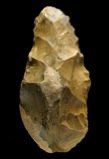May 2009
Who made the Aurignacian?
30/05/09 23:40 Filed in: Palaeoanthropology
Until recently, it was largely assumed that the Aurignacian was contemporaneous with the arrival of anatomically modern humans in Europe sometime around 40,000 years ago. This industrial complex is named after the site of Aurignac in southern France and is found throughout Europe and southwest Asia. The evidence for an association between modern humans the Aurignacian has been less than clear cut.
For most of the last century, the prevalent view among archaeologists was that Neandertals only made Mousterian tools. However, the discovery of the St Césaire 1 Neandertal skeleton and the Neandertal remains from Arcy-sur-Cure with Châtelperronian industry put paid to this idea. Châtelperronian tools show a mix of features otherwise found in the Mousterian and Aurignacian industries. What was particularly surprising about the Châtelperronian culture was not only the lithics but also the manufacture of bone tools and personal ornaments. At the site of Arcy-sur-Cure archaeologists found pierced teeth, ivory, shell, and bone in the Châtelperronian layers. The Szeletian industry of central Europe and the Uluzzian industry of Italy may also be related to the Châtelperronian.
Read More...
For most of the last century, the prevalent view among archaeologists was that Neandertals only made Mousterian tools. However, the discovery of the St Césaire 1 Neandertal skeleton and the Neandertal remains from Arcy-sur-Cure with Châtelperronian industry put paid to this idea. Châtelperronian tools show a mix of features otherwise found in the Mousterian and Aurignacian industries. What was particularly surprising about the Châtelperronian culture was not only the lithics but also the manufacture of bone tools and personal ornaments. At the site of Arcy-sur-Cure archaeologists found pierced teeth, ivory, shell, and bone in the Châtelperronian layers. The Szeletian industry of central Europe and the Uluzzian industry of Italy may also be related to the Châtelperronian.
Read More...
0 Comments
The origin of bone words
29/05/09 17:31 Filed in: Linguistics
Skull
Temporal: Comes from a Latin word meaning a correct mixture or balance in the sense of tempering a metal. It later came to mean a mental balance. It is related to the word temper which we have come to associate with its negative sense, i.e. to lose one's temper.
Sphenoid: Many bones are named for their shape like this one which comes from the Greek sphēnoeidēs meaning wedge-like.
Orbit: The Latin word orbis had the meaning of round or spherical and referred to the shape of the eye sockets.
Nasal: Latin nasus meaning nose.
Nasal concha: Concha is the latin word for a shell or mollusk.
Vomer: This word means ploughshare or stylus in Latin and the bone is so named for its shape.
Lacrimal/Lacrymal: This bone, located in the eye socket, gets its name from the Latin word for tear, lacrima.
Ethmoid: From the Greek word ēthmos meaning sieve. Read More...
Temporal: Comes from a Latin word meaning a correct mixture or balance in the sense of tempering a metal. It later came to mean a mental balance. It is related to the word temper which we have come to associate with its negative sense, i.e. to lose one's temper.
Sphenoid: Many bones are named for their shape like this one which comes from the Greek sphēnoeidēs meaning wedge-like.
Orbit: The Latin word orbis had the meaning of round or spherical and referred to the shape of the eye sockets.
Nasal: Latin nasus meaning nose.
Nasal concha: Concha is the latin word for a shell or mollusk.
Vomer: This word means ploughshare or stylus in Latin and the bone is so named for its shape.
Lacrimal/Lacrymal: This bone, located in the eye socket, gets its name from the Latin word for tear, lacrima.
Ethmoid: From the Greek word ēthmos meaning sieve. Read More...
Darwinism: The creationist straw man
27/05/09 21:10 Filed in: Scepticism
If you visit the ironically entitled creationist website Evolution News and Views, try finding a single post that doesn't mention the word “Darwinist” or “Darwinism”. You’ll have to dig deep… very deep. If you were completely ignorant of biology you might even be fooled into thinking that these were terms cheerfully embraced by the scientific community. After all, an evolution news outlet is hardly in the business of obfuscation, now is it?
Outside of intelligent design (i.e., creationism warmed-over), Darwinism is used primarily to refer to the theory of the evolution of species by natural selection, as formulated by Darwin, not to the modern and more complete understanding of evolution. As things tend to be in science, evolutionary theory hasn’t stood still since 1859, when Darwin communicated his ideas to the world in On the origins of species. While natural selection is indeed a principle driving force in evolution, it is not the whole story. Charles Darwin would no doubt be astonished by the such discoveries of genes and DNA, the reworking of evolutionary theory to accommodate evo-devo and neutral theory, as well as the plethora of evidence that has confirmed the basic tenets of his original ideas. To use the term Darwinism is an insult to the hard work of the thousands of scientists who have helped refine evolutionary theory. It implies that the wheels of scientific research ground to a halt some 150 years ago and serves to confuse the public’s already poor understanding of evolution. Read More...
Outside of intelligent design (i.e., creationism warmed-over), Darwinism is used primarily to refer to the theory of the evolution of species by natural selection, as formulated by Darwin, not to the modern and more complete understanding of evolution. As things tend to be in science, evolutionary theory hasn’t stood still since 1859, when Darwin communicated his ideas to the world in On the origins of species. While natural selection is indeed a principle driving force in evolution, it is not the whole story. Charles Darwin would no doubt be astonished by the such discoveries of genes and DNA, the reworking of evolutionary theory to accommodate evo-devo and neutral theory, as well as the plethora of evidence that has confirmed the basic tenets of his original ideas. To use the term Darwinism is an insult to the hard work of the thousands of scientists who have helped refine evolutionary theory. It implies that the wheels of scientific research ground to a halt some 150 years ago and serves to confuse the public’s already poor understanding of evolution. Read More...
Argumentum ad hominem
26/05/09 22:56 Filed in: Scepticism
As I noted in an earlier post, this blog was partly named as a misspelt pun on the ad hominem argument. Argumentum ad hominem (Latin: "argument to the man") involves attacking the character or circumstances of one's opponent in order to undermine them, instead of addressing the substance of their argument. Ad hominem arguments are generally regarded as fallacious, since they do not address the opponent’s argument itself.
This argument comes in the following forms:
Abusive
The tactic is to portray the opponent as a bad or immoral person, and conclude based on this, that their argument should not be accepted, e.g.
This argument comes in the following forms:
Abusive
The tactic is to portray the opponent as a bad or immoral person, and conclude based on this, that their argument should not be accepted, e.g.
Ann says that anthropological research needs more funding. This is coming from a woman who divorced her husband.
Read More...
Race: an anthropological perspective
23/05/09 16:38 Filed in: Biological Anthropology | Cultural Anthropology
Forensic anthropologists often have to establish a biological profile of an individual based on their skeletal remains. This involves establishing probable age, sex, stature and race. The last category seems to be at odds with the consensus view in modern biology, which views the race concept to be biologically meaningless. Since this is the case, then why do forensic anthropologists insist on determining race?
Alice Brues defined race as "a division of a species which differs from other divisions by the frequency with which certain hereditary traits appear among its members." This definition of race, like most others, is rather equivocal, in that it does not tell us how much variance in the frequency of traits necessitates the creation of a new race. If we take this definition at face value then according to craniometric and genetic data an incalculable number of races exist.
In 1972, R.C. Lewontin reported that, for genes at a single locus, most genetic variation existed within populations, rather than between them. For most biologists this put the nail in the coffin for the race concept. In a re-examination of Lewontin's findings, the Cambridge statistician A.W.F. Edwards, noted that our ability to correctly classify populations is due to the correlations among different loci. By focusing on multiple loci the between population differences increase dramatically. Read More...
Alice Brues defined race as "a division of a species which differs from other divisions by the frequency with which certain hereditary traits appear among its members." This definition of race, like most others, is rather equivocal, in that it does not tell us how much variance in the frequency of traits necessitates the creation of a new race. If we take this definition at face value then according to craniometric and genetic data an incalculable number of races exist.
In 1972, R.C. Lewontin reported that, for genes at a single locus, most genetic variation existed within populations, rather than between them. For most biologists this put the nail in the coffin for the race concept. In a re-examination of Lewontin's findings, the Cambridge statistician A.W.F. Edwards, noted that our ability to correctly classify populations is due to the correlations among different loci. By focusing on multiple loci the between population differences increase dramatically. Read More...
A little human with very big feet
13/05/09 10:50 Filed in: Palaeoanthropology

The pelvis and legs all clearly demonstrate that Homo floresiensis was bipedal. However, the hominin’s feet are unusually long compared to the leg. This combination of a long foot and a relatively short leg is seen in some apes but not in hominins. The navicular acts like the keystone in the arch of the human foot and is elevated from the ground except in people who have fallen arches. Read More...
Is craniometry scientific?
13/05/09 10:07 Filed in: Biological Anthropology | Scepticism

Ad Hominin. What's in a name?
13/05/09 10:04 Filed in: Scepticism
Until quite recently humans and their ancestors were referred to as hominids. This was a reflection of taxonomy of the time: the family Hominidae consisted of humans, while the family Pongidae consisted of orangutans, chimpanzees, gorillas and bonobos. However, molecular studies showed humans, chimpanzees and bonobos to be more closely related than previously thought. The current consensus taxonomy for the family Hominidae consists of the following subfamilies: Ponginae (orangutans), Gorillinae (gorillas) and Homininae (chimpanzees, bonobos, humans). Strictly speaking chimps, bonobos and humans are all hominids. However, we still need a way to talk about ourselves and our ancestors. The Homininae subfamily is divided into two tribes: Panini (chimpanzee, bonobo) and Hominini (humans). Thus, in recent years there has been a growing trend of referring to humans and their ancestors as hominins. Read More...





